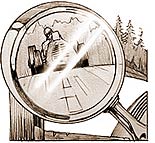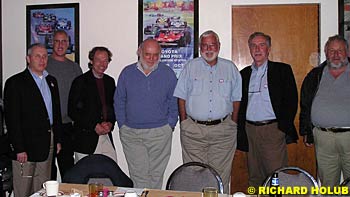

Backward glances at racing history
Atlas F1 Columnist
The First Weekend in October at Watkins Glen, 2003
On this very date 55 years ago, the very first running of a road race in the United States after the Second World War. This was a fact that was difficult to ignore since one of the folks I spoke to that day was Cameron Argetsinger, literally the driving force behind that effort in 1948. Argetsinger is currently the president of the International Motor Racing Research Center (IMRRC) located at Watkins Glen. The IMRRC had asked Doug Nye, a well-known and highly respected author, to come to Watkins (very few of the "natives" call it The Glen, Watkins being the name of the village until the 1920's) and participate in their Saturday speaker series.
Mike Argetsinger and I drove to Rochester - literally through a wall of hail just north of Watkins, as well as sleet, snow, and rain - to pick up Doug and bring him back to Watkins Glen for the first time since 1974. The journey back was great fun since Doug has a certain dry sense of humor (or is it "humour?") and is bursting with stories. That he had just wrapped up the book that he and Jack Brabham were working on meant that he was certainly on form with no end of Jack Brabham stories.
On Friday, Doug was driven around the original 6.6-mile road course used from 1948 to 1952. The driver was a certain C.R. Argetsinger who drove a red 1948 MG TC - number "2" in the program - in the very first races held at Watkins Glen in 1948, the "Junior Grand Prix," and "Watkins Glen Grand Prix." As Doug discovered, Cameron Argetsinger can still pilot a car very rapidly through the countryside.
On Saturday, Doug Nye asked Mike Argetsinger and I to see about letting him take another lap of the "old" course to take some more pictures. The research librarian of the IMRRC, Mark Steigerwald, was very gracious to lend us his Subaru WRX for this task, especially considering that Mike is a bona fide racer, as is his brother Pete. We were able to get some great "action" shots at certain points on the course, especially at the railroad crossing. I think Doug will be furnishing Mark with his own copy of just how well the WRX can land after being launched...
After the first part of an Open House at the IMRRC, the many who assembled that afternoon to hear Doug Nye speak (over 100 people), filed over to the auditorium of the adjacent elementary school - there was not enough room in the IMRRC for everyone! - for an eagerly awaited talk. After the opening remarks by the hard-working Glenda Gephardt (the Communications Director of the IMRRC and who did a great job organizing the event), plus having to endure an introduction by an obscure columnist, Doug Nye finally took the podium.
For two hours Nye held the attention of the audience. Rather than just "talk" and show "pictures," Nye suggested that there is much to be learned from the use of "moving pictures" when delving into the history of motor racing. Using materials compiled by his associate David Weguelin, Nye showed a series of "moving images" which when backed up by the comments and observations of Nye, certainly make that point crystal clear, at least to me.
The first segment was what might be called the pre-War German approach to presenting motor racing. The images were just as appropriate for a grand German opera as a motor race. The angles and the ways the cameras tracked the cars in action were meant to convey a sense of power and force that was closely aligned with the reason the National Socialists bankrolled the sport in the first place. Some of the images were nothing short of remarkable, especially the Graf Zeppelin emerging from the clouds and floating past Schloss Nurburg. It was just as remarkable to see the Mercedes W154's emerge from the Karusell and literally rocket away at speeds that even today would get your attention. Grand stuff and as overpowering today as it was then.
The there was a piece on Prince Bira which was a sharp contrast to the might and power depicted by the German film makers. The rather low key, almost nonchalant attitude of the pre-War English racing scene was a stark contrast to that of the highly organized and efficient Germans. To see the action at Brooklands with Bira manhandling the ERA's of the White Mouse Stable and then seem to brush it off was a reminder to remember that the images of Bira and the mighty German machines were from literally the same years, although they seemed to be from different ages and not merely different countries.
The next segment was a series of films from the year 1951 in the United States. The first part showed scenes from Watkins Glen and no end of expertise in the audience on this one. The Bridgehampton race from that year was next. Many unfamiliar with American road racing in this era are surprised to find that prior to the racing circuit being built in Bridgehampton, that they also raced through the local roads just like they did at Watkins Glen. Absolutely great material. There was also a great piece of film on the Palm Beach Shores race, with one particular shot that showed Phil Walters rocketing through a corner in a four-wheel drift that literally took your breath away. It was to see a true master at work.
When Nye previewed the next part of the material from 1951, he had a question as to the exact location of the race, but when several of us immediately yelled, "Vero Beach!", his guess as to the local proved correct. Some very good footage of this race. The last piece of film in this segment was from the first Sebring 12-hour event held in 1952. Again, it was fascinating to see the huge variety of the cars competing in the race and realize that even decades later that idea seems to still be around, even if a bit shaped by the intervening years and the meandering direction of American sports car racing.
The next segment was perhaps the part that affected me the most: the DSJ Cottage. For those who are unaware of just who "DSJ" was, those are the initials - the practice of MotorSport at the time was to indicate the author of a piece by merely indicating that identity through the use of initials - of Denis Sargent Jenkinson. Jenkinson - or as everyone usually referred to him, "Jenks" - was a Character in a sport chock full of Characters. For decades, Jenks wandered about The Continent filing race reports, letter, and other observations which filled the pages of MotorSport and hooked no end of us on the sport. Jenks, however, was something of a man of mystery. He lived in a cottage that few visited or even knew existed until after his death.
The next segment consisted of some video that Nye himself took at the top of the hill at the Goodwood Festival of Speed. The car park there of the cars that had completed their runs was enough to make even the most hardened car nut gape in awe. Another part of this segment was an exciting race during the 1998 Goodwood Revival.
Lastly, we proles got to see what only those in white ties and mucho dinero saw as they celebrated the 50th World Drivers' Championship Season - a spectacular montage that David Weguelin assembled and which effectively used music that Walter/Wendy Carlos (don't ask) composed for the film, A Clockwork Orange. It was dynamite stuff and nothing short of rousing.
And suddenly, there we were two hours after we started! It flew past and that was a great testament to the skill of Doug Nye and David Weguelin.
That evening, many of us gathered at the Seneca Lodge for supper with Doug, the Argetsingers, and many of those at the IMRRC who had made this weekend possible. It was a great occasion and one that I will remember for years to come.
Great credit must be given to the Argetsingers - Cameron, Jean, and Mike - and the IMRRC for taking the opportunity to bring Doug Nye in as a guest speaker and ensuring that he was available to the many guests for chats and "private moments." Doug Nye is one of those Scribes whose curiosity is as sharp as ever and who is unafraid to ask questions and admit that he may not know something - but, he will find someone who does. While a great admirer of Doug Nye prior to this, I left Watkins and headed south on Sunday as someone who had been privileged to spend time in the presence of The Real Deal.
Thanks Doug!
Early on the morning of 2 October, I left my home in Northern Virginia and took the familiar route northward into Maryland and Pennsylvania on my way to a small village in New York. Just south of the New York - Pennsylvania line, I drove through a very fierce snow storm which was proof - as if any were needed - that this was indeed the first weekend in October. The small village in New York? Watkins Glen.
 Doug Nye was an executor of the Jenkinson estate and, therefore, knew Jenks quite well. Although the cottage is now gone, Nye and a companion made a record of the contents of the cottage at the time just before Jenkinson died. It was an extraordinary experience and one difficult to describe. For those o us who had but a fleeting moment or two with Jenks, but followed his writing with a passion that has been undiminished with the passage of time (even when we didn't agree with him), it was a window into a life that we scarcely knew. This was the first time this material had ever been seen in public. I, for one, admit to being quite moved by some of the simple possessions of Jenks and what they must have meant to him
Doug Nye was an executor of the Jenkinson estate and, therefore, knew Jenks quite well. Although the cottage is now gone, Nye and a companion made a record of the contents of the cottage at the time just before Jenkinson died. It was an extraordinary experience and one difficult to describe. For those o us who had but a fleeting moment or two with Jenks, but followed his writing with a passion that has been undiminished with the passage of time (even when we didn't agree with him), it was a window into a life that we scarcely knew. This was the first time this material had ever been seen in public. I, for one, admit to being quite moved by some of the simple possessions of Jenks and what they must have meant to him
Please Contact Us for permission to republish this or any other material from Atlas F1.
|
Volume 9, Issue 45
Atlas F1 Special
The Knock on the Door
2003 Season Review
The Season of What If
How Would F1 Score in Other Series
Columns
The Fuel Stop
Rear View Mirror
Bookworm Critique
On the Road
Elsewhere in Racing
The Weekly Grapevine
> Homepage |